Traditional Dyes and Crafts used in the Collections
Home | Janan | Poshan | Vardhan | Rakshan | Parayan
Natural Dyes:
Common Name: Pomegranate (Anar)
Botanical Name: Punica granatum
Range of colors: Shades of Green & Yellow
Medicinal Properties:
- Antibacterial, antiviral, astringent
- Antimicrobial treatment, hypertension
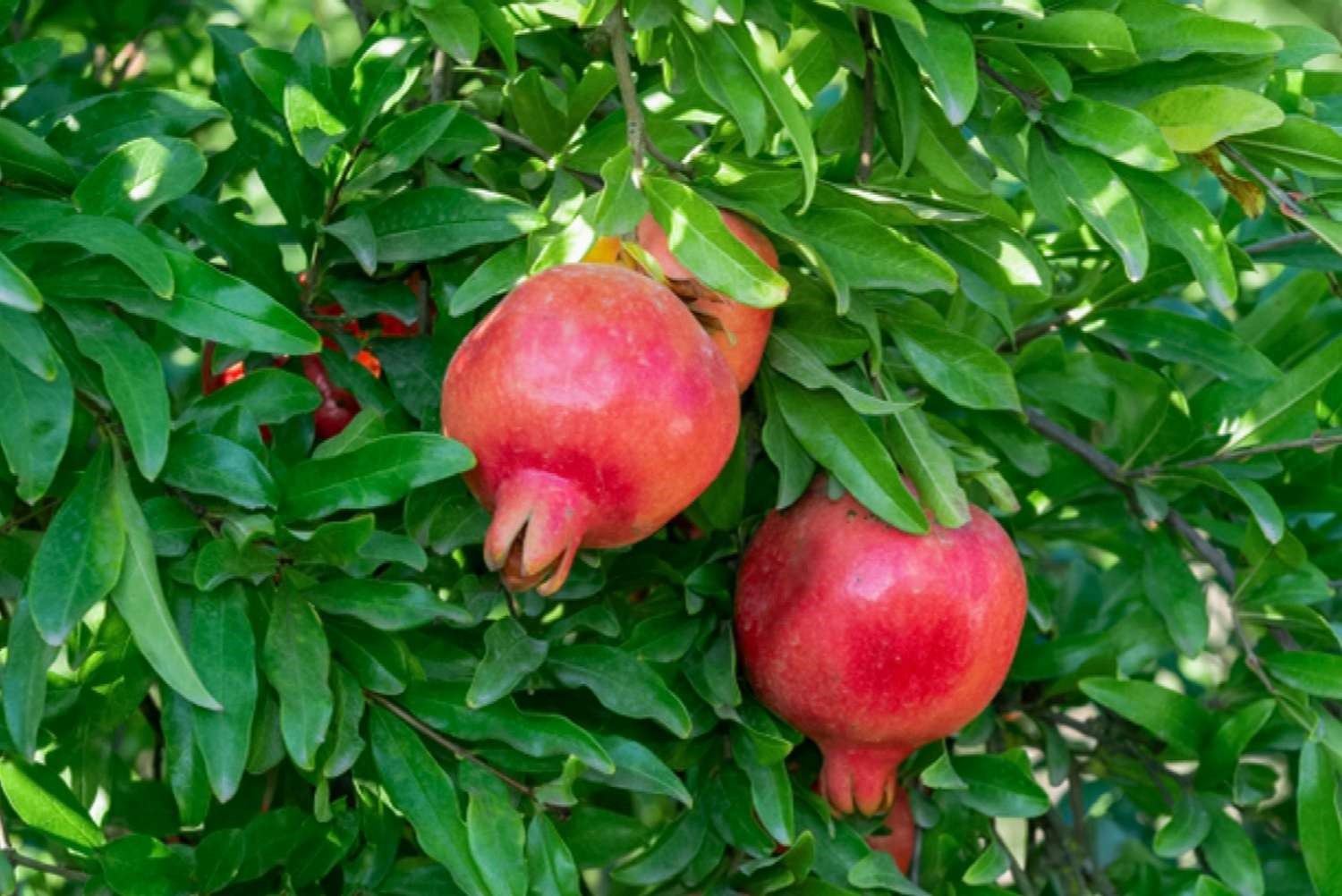
Common Name: Myrobalan (Harda)
Botanical Name: Terminalia chebula
Range of colors: Shades of Yellow
Medicinal Properties:
- Antiseptic, anti-inflammatory, controls cholesterol
- Hypertension, anemia, asthma cures, wounds, ulcers
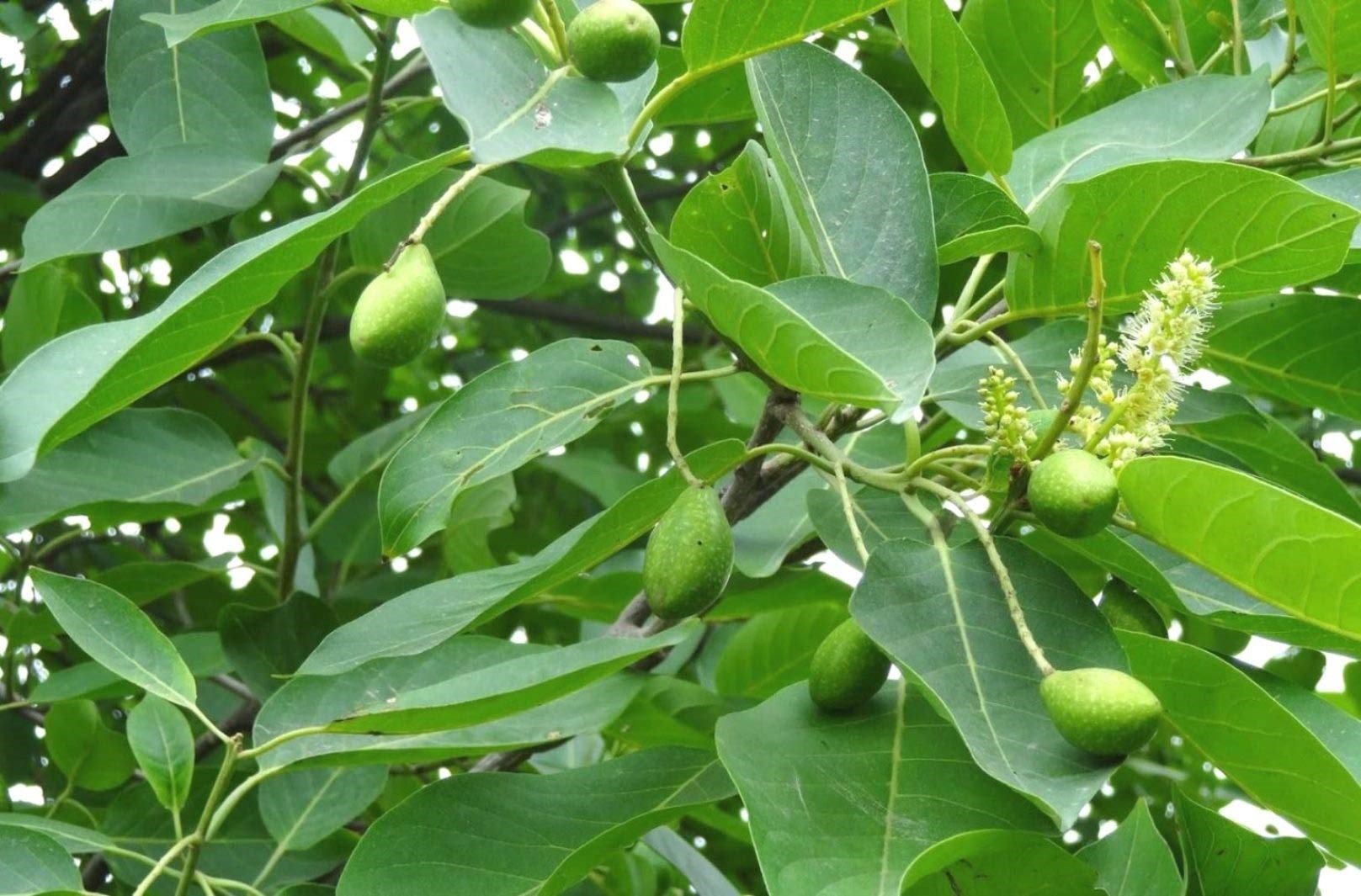
Image Source : https://m.media-amazon.com/images/I/71J-SN+5rgL._SL1500_.jpg
Common Name: Jamun
Botanical Name: Syzygium cumini
Range of colors: Shades of Purple & Red
Medicinal Properties:
- Controls blood sugar levels
- Diabetes controls blood sugar levels
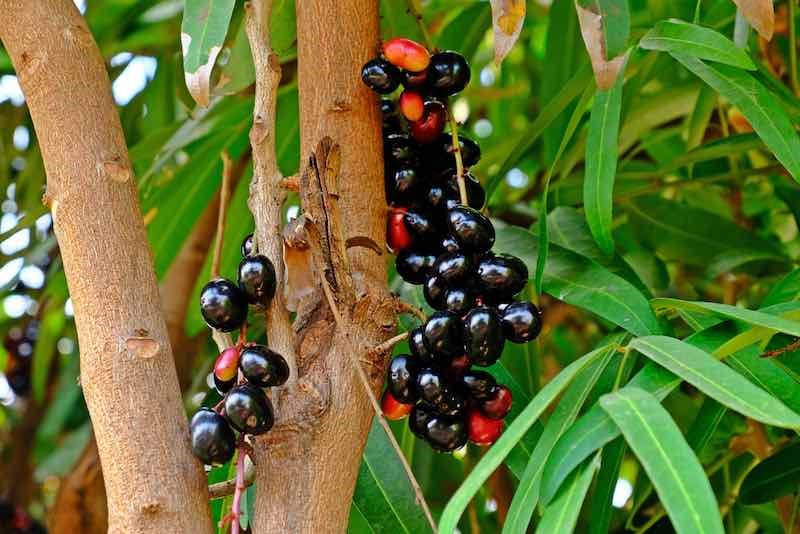
Image Source : https://www.shutterstock.com/image-photo/bunch-organic-blood-red-black-java-1930959959
Common Name: Mulberry
Botanical Name: Morinda pubescens
Range of colors: Shades of Deep Red, Brown & Purple
Medicinal Properties:
- Antibacterial, anti-inflammatory
- It is blood purifier and used for wound healing, control diabetes
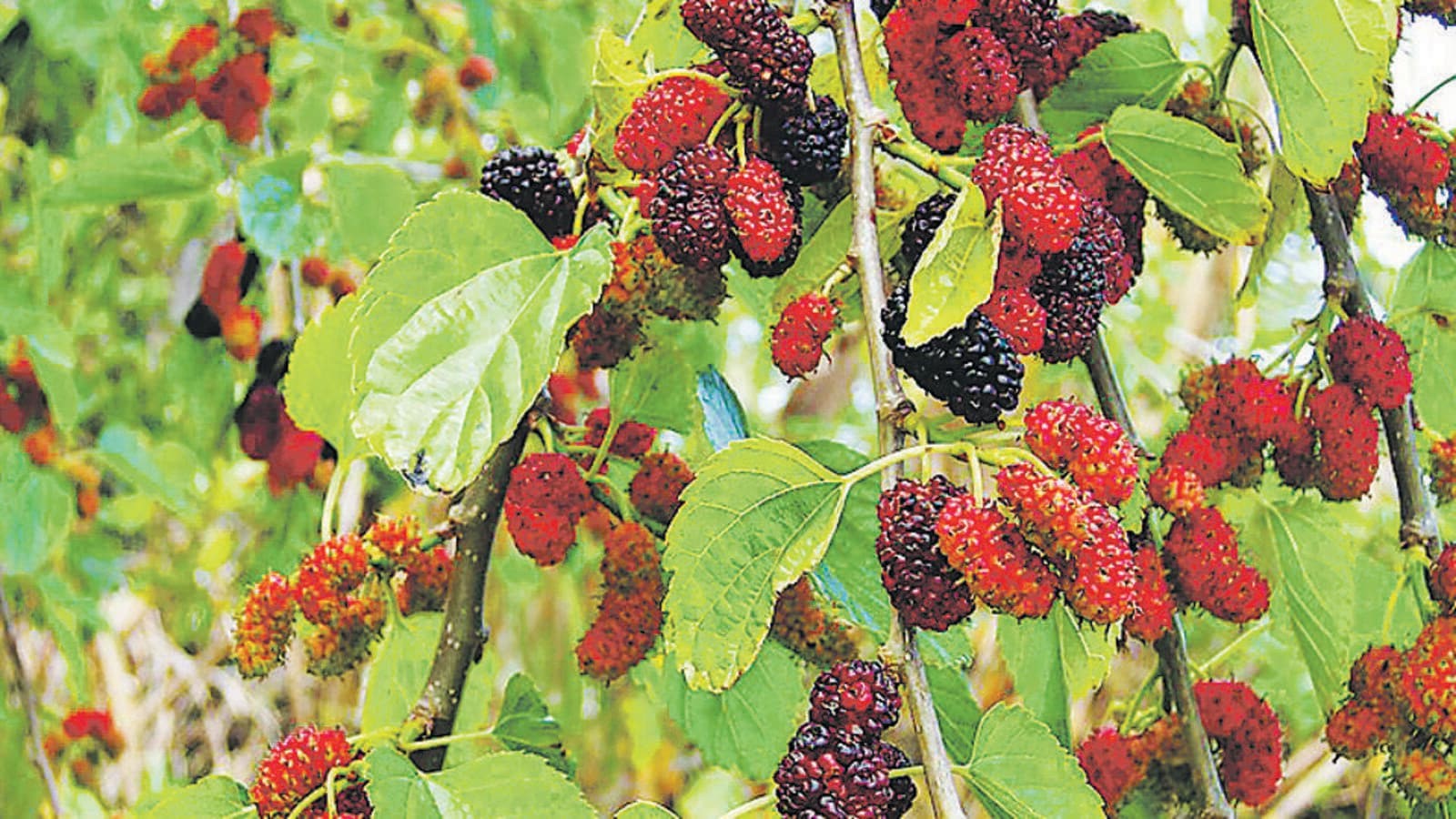
Image Source : https://www.hindustantimes.com/ht-img/img/2023/03/09/550x309/The-mulberry-required-only-careful-attention--the-_1678358351467.jpg
Common Name: Acacia (Babool)
Botanical Name: Catechu
Range of colors: Shades of Brown
Medicinal Properties:
- Antifungal, antibacterial
- Used for treatment of parasitic infestation and itching
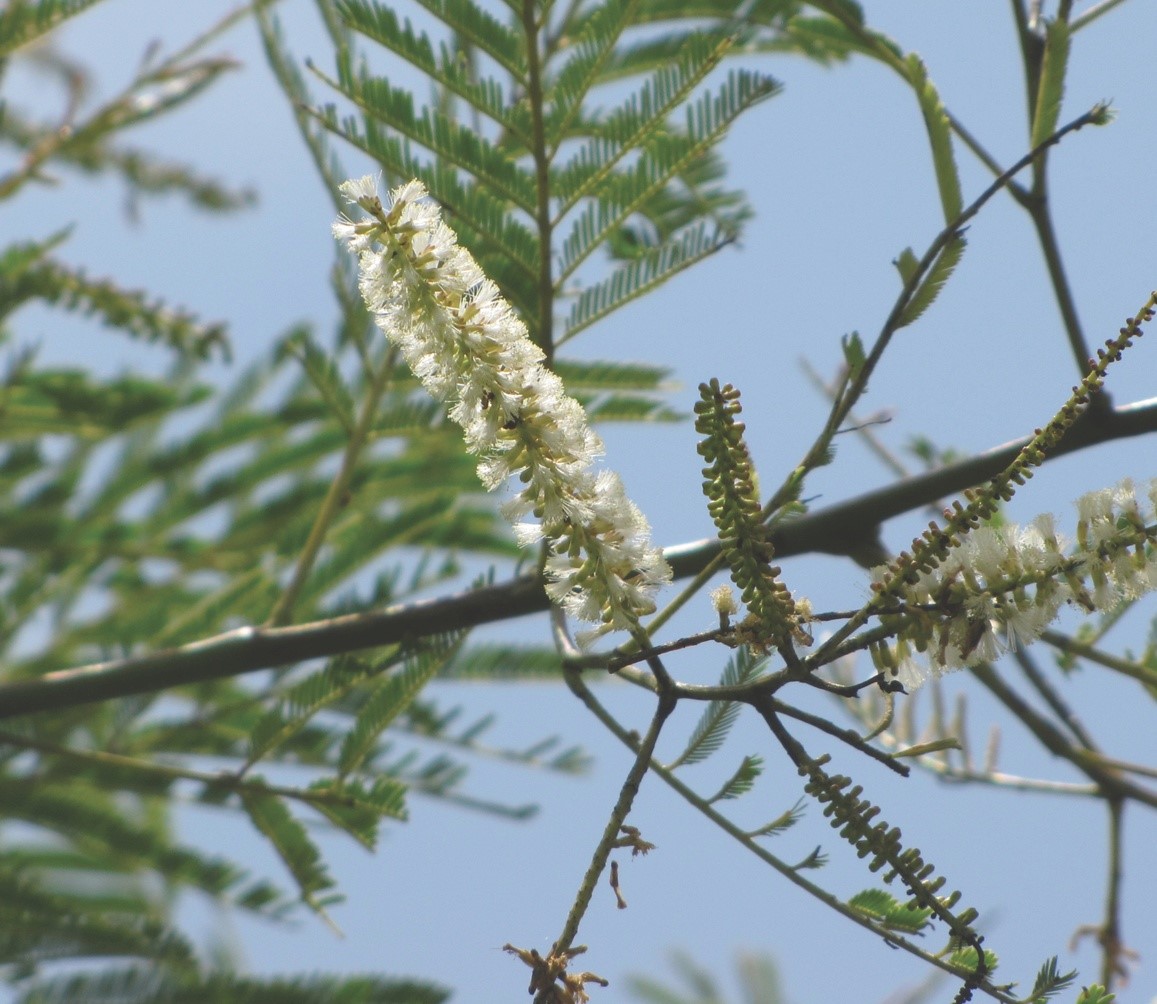
Image Source : https://indiabiodiversity.org/files-api/api/get/crop/img//Acacia%20catechu/Acacia_catechu_flower.jpg?h=500
Common Name: Madder (Manjistha)
Botanical Name: Rubia cordifolia
Range of colors: Shades of Red, Pink & Orange
Medicinal Properties:
- Antibacterial, anti-inflammatory, antiseptic, astringent, sedative, stimulant
- Blood purifier and diuretic, leprosy
- It removes blood impurities and cures various skin diseases, HIV/AIDS
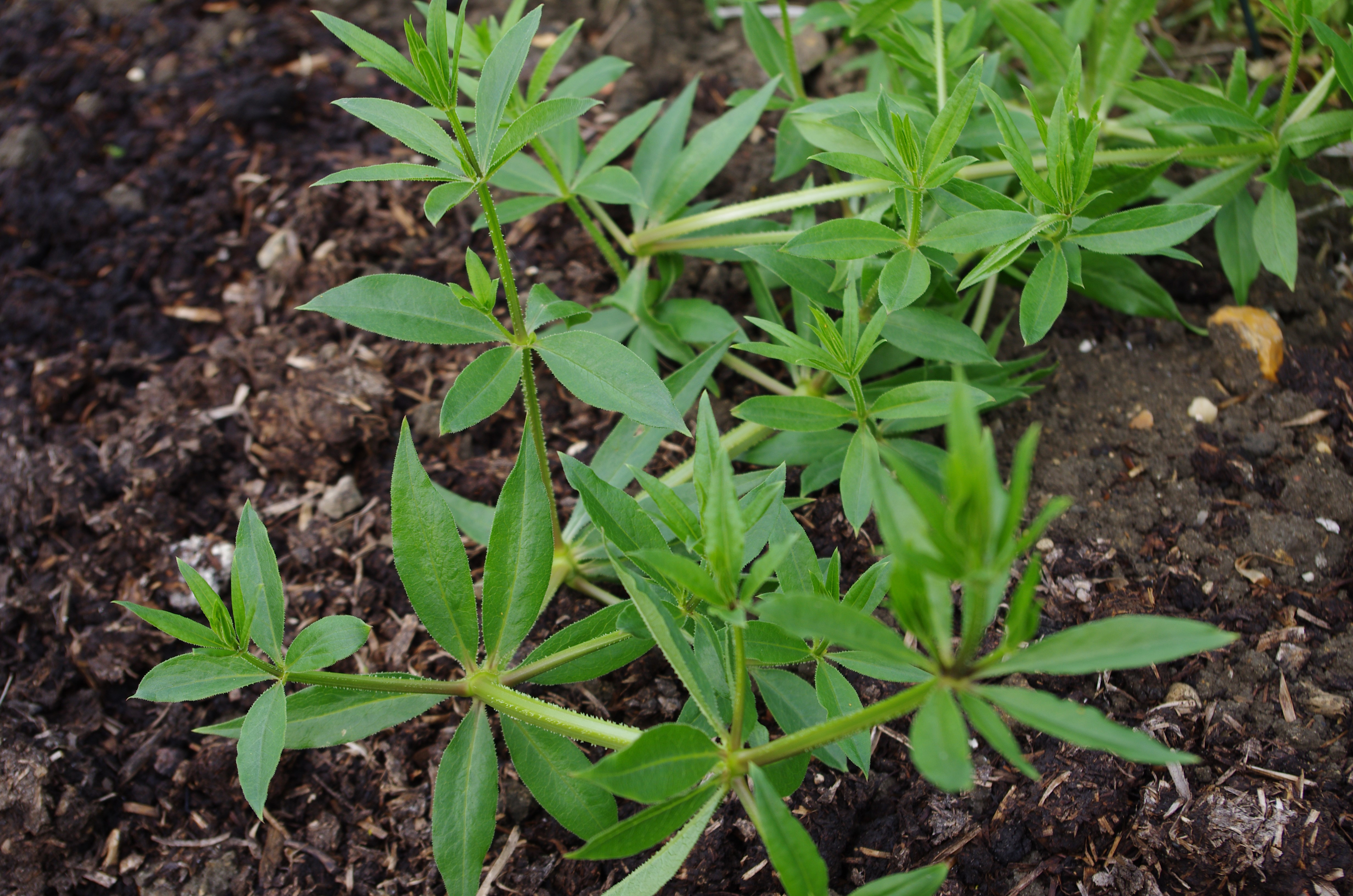
Image Source : https://www.naturesrainbow.co.uk/wp-content/uploads/2017/01/Madder-768x509.jpg
Traditional Craft:
Craft Name: Marori Embroidery (Type of Zardozi)
Location: Lucknow, Uttar Pradesh
Community: Mostly Muslim
Similar Crafts in the world: Metal embroideries
Marori is a century old craft practised and developed as a part of the zardozi embroidery. The Marori stitch constitutes an important variant of zardozi embroidery as an ancient Persian art of metallic applique embroidery. It involves the zari (metallic) thread being twisted and coiled in different ways and couched onto the fabric to form patterns and designs.
Zardozi is a form of hand embroidery, that originated in Persia whereas “zar” means gold and “dozi” means embroidery. The embroidery involves the decoration of fabric with a special hook needle, metallic threads, colourful yarn, pearls, beads, quills, sequins etc. The Mughal conquerors introduced this heavy and unique style of hand embroidery to India. In the Mughal era, zardozi work was used to decorate tent walls in the form of wall hangings as well as accessories for royal elephants and horses. Zardozi's workmanship differs from other traditional Indian embroideries like chikankari, sujni, kantha, kasuti, toda etc. Traditionally, the Muslim communities residing in different parts of India executed zardozi work. The zardozi designs and subjects vary in different parts of the country.
Process:
- The plain fabric that has to be embroidered is framed tightly to the round or rectangular wooden frame.
- The required patterns or designs are created directly on the fabric with the tailor’s chalk or transferred through tracing paper.
- The artisan starts with an aari chain stitch. The stitches are done by holding the thread with a finger at the reverse of the framed fabric and an aari hook, a sharp-pointed awl-like needle, held on the top.
- The aari hook is pierced through the cloth to pull up the thread from the backside of the framed cloth and each stitch new stitch tightens the previous one.
- These stitches are similar to the cobbler’s stitch and the process of embroidering is repeated until the required design is formed on the surface of the fabric.
- Sequins, beads or twisted metallic wires maybe used additionally to enrich the embroidery.
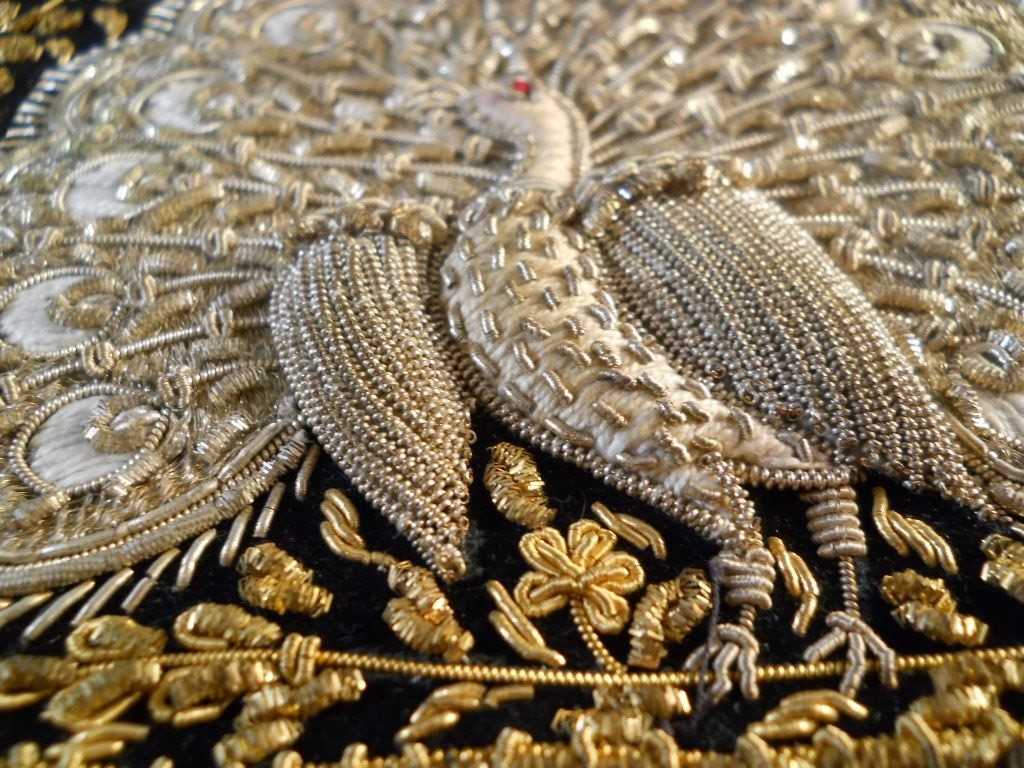
Source :
https://www.prakati.in/talking-threads-celebrating-ancient-indian-textiles/#:~:text=The%20Marori%20stitch%20is%20a,to%20form%20patterns%20and%20designs.
https://www.dsource.in/resource/aari-zardozi-ahmedabad-gujarat/making-process.
https://www.dsource.in/resource/aari-zardozi-ahmedabad-gujarat/introduction.
https://4.bp.blogspot.com/-zSNZ2RKrEvc/Ur1pZDnuS1I/AAAAAAAAKnw/eX0NN4g5PXc/s1600/zardozi+peacock.jpg.
Craft Name: Dori Embroidery
Location: Lucknow, Uttar Pradesh
Community: Not Specific
Similar Crafts in the world: Most of Silk thread embroideries
Dori – is said to have been derived, from the Hindi language, roughly translating to mean 'thread'. This form of embroidery-work is versatile in the true sense, owing to the vast variety of colours and stitching styles that can come under this form of embroidery. A distinct feature of Dori embroidery is the apparent thickness of the thread that gives this embellishment a 3- dimensional appearance. A careful combination of refined Silk and Cotton threads is used to make the ‘Dori’.
Zardozi stitches and couching stitch-works are taken under the wings of Dori work, accompanied with multi-coloured and finest quality of threads.
Process:
- The motifs or patterns are first imprinted onto the fabric, utilizing a stencil/silhouette impression.
- Once the patterns are drawn, the refined resham (silk) and cotton threads are twisted together to form one single Dori.
- The Dori is used to trace the motif designs and patterns drawn on the fabric.
- The artisans use other embroidery stitches in order to add improvisations if necessary.
- Aesthetic colour threads are used to enhance the overall look.
- Dori Embroidery can be practiced by hand or using an embroidery machine.
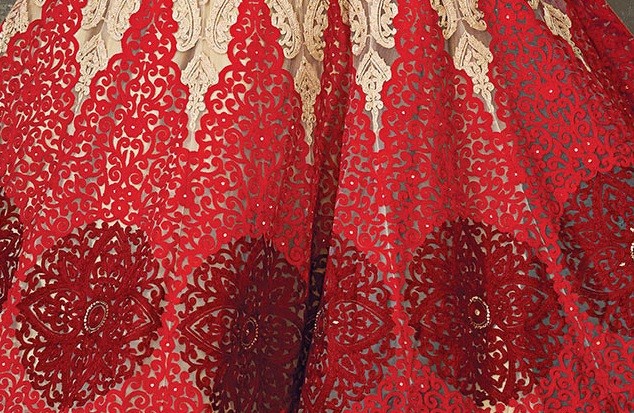
Source :
https://www.faridagupta.com/blog/art-of-dori-embriodery#:~:text=The%20motifs%20or%20patterns%20are,process%20is%20the%20tracing%20work
https://www.utsavpedia.com/motifs-embroideries/unveiling-the-thread-world-of-fashion-dori-work/#:~:text=Origin%20and%20History,a%20%27stitched%20work%27%20essence
https://www.utsavpedia.com/wp-content/uploads/2013/06/dori.jpg
Craft Name: Khari Printing
Location: Gujarat, Rajasthan
Community: Not Specific
Similar Crafts in the world: Tinsel printing
Precious metal Varak leaf created by flattening gold or silver to a fine paper like consistency was hand printed onto flags, coats of arm, royal tents and other insignias of power to reflect the status and prestige of the possessor. Embellishing sacred textiles, the tradition of Varak leaf printing continues to be employed to decorate temple textiles today.
Glittering Varak leaf prints, resembling the costly brocades woven with precious metal threads and zari embroideries, were more reasonably priced; the textiles however did not lend themselves to the rigours of washing and their gleam fading away over time.
The making of Varak printed textiles can be traced to large temple towns and several erstwhile royal cities in India. Now the traditional practice of Varak block printing is rare.
Unlike other block printing processes Khari printing is a surface embellishment and does not permeate the textile surface. Its usage thus extends to plain, dyed, printed, embroidered or otherwise finished textiles. Though originally printed on different varieties of cotton or silk, the versatility of the printer now extends not only to the wide range of contemporary textile, but to paper as well.
Process:
- The process starts with the specially prepared Roghan gum paste made of a cooked mixture of castor oil.
- Followed by the addition of other ingredients that include turpentine, further heated, thickened and strained till the paste achieves the acceptable printing consistency.
- The stamping tools used in Khari printing are also different from other forms of block printing. An ingenuous system it uses two different blocks, closely fitted into each other. The outer sancha or metal case made of brass, has the perforated design to be printed onto the surface of its base. The inner component of the sancha is the hatha wooden mallet, fitting perfectly into the metal sleeve. The hatha performs the task of a plunger. The sancha can be round, square, or any shape according to the motif/design.
- The hatha forces the thick viscous roghan paste through the perforation to form the motif on the textile. This is only the first phase in the printing process.
- While the roghan paste has not yet set, metal powders or mica abrakh powders are dusted on, adhering to the roghan.
- When dried any excess powder is removed and saved for further use, while the glittering textile is ready for use.
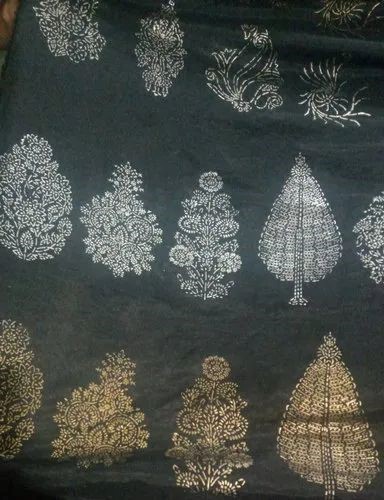
Source :
https://artsandculture.google.com/story/IwVxwKAHCAcA8A
https://artsandculture.google.com/asset/gold-and-silver-dust-khari-handblock-printing-jaipur-and-ahmadabad/6QG2ZMiYW-k4QQ?hl=en
https://5.imimg.com/data5/ANDROID/Default/2020/12/AB/EQ/VO/49299082/product-jpeg-500x500.jpg
Craft Name: Patch Work
Location: Kutch, Gujarat
Community: Not Specific
Similar Crafts in the world: Barmer, Bikaner; Rajasthan
The art of sewing patches of geometrically shaped fabric together to form a textile pattern is called patchwork. The bright-coloured patchwork of a well-composed arrangement of triangles and squares attracts any individual and retains them as being favoured textile products.
The history of Indian applique and patchwork can be traced back to the times when folk women of native communities in Gujarat produced large canopies, tents for ox carts, and hangings were stitched. Gujarat applique is mostly focused on patchwork in which the various patterned and coloured fabric pieces are cut in different sizes and shapes to sew them together to form a composed piece of artwork. The colour palette of applique and patchwork designed by Gujarat artists varies from cool to warm colours, and bright to neutral tones.
Process:
- The materials used for applique patchwork are usually cotton fabrics.
- To fabricate an applique patchwork initially the base of the product has to be prepared.
- The base can either be a plane textile or a base prepared using patchwork.
- The artisan at Kutch prepares the base by patchwork.
- They initially decide on the design of it. The required size of the coloured fabrics is cut into shapes needed for the pattern.
- All the cut pieces of fabric are laid on a flat surface to check the pattern.
- Once the pattern is set, pieces of fabric are sewn together facing inwards by creating the required form.
- Thus the base of the applique patchwork is made and ironed neatly.
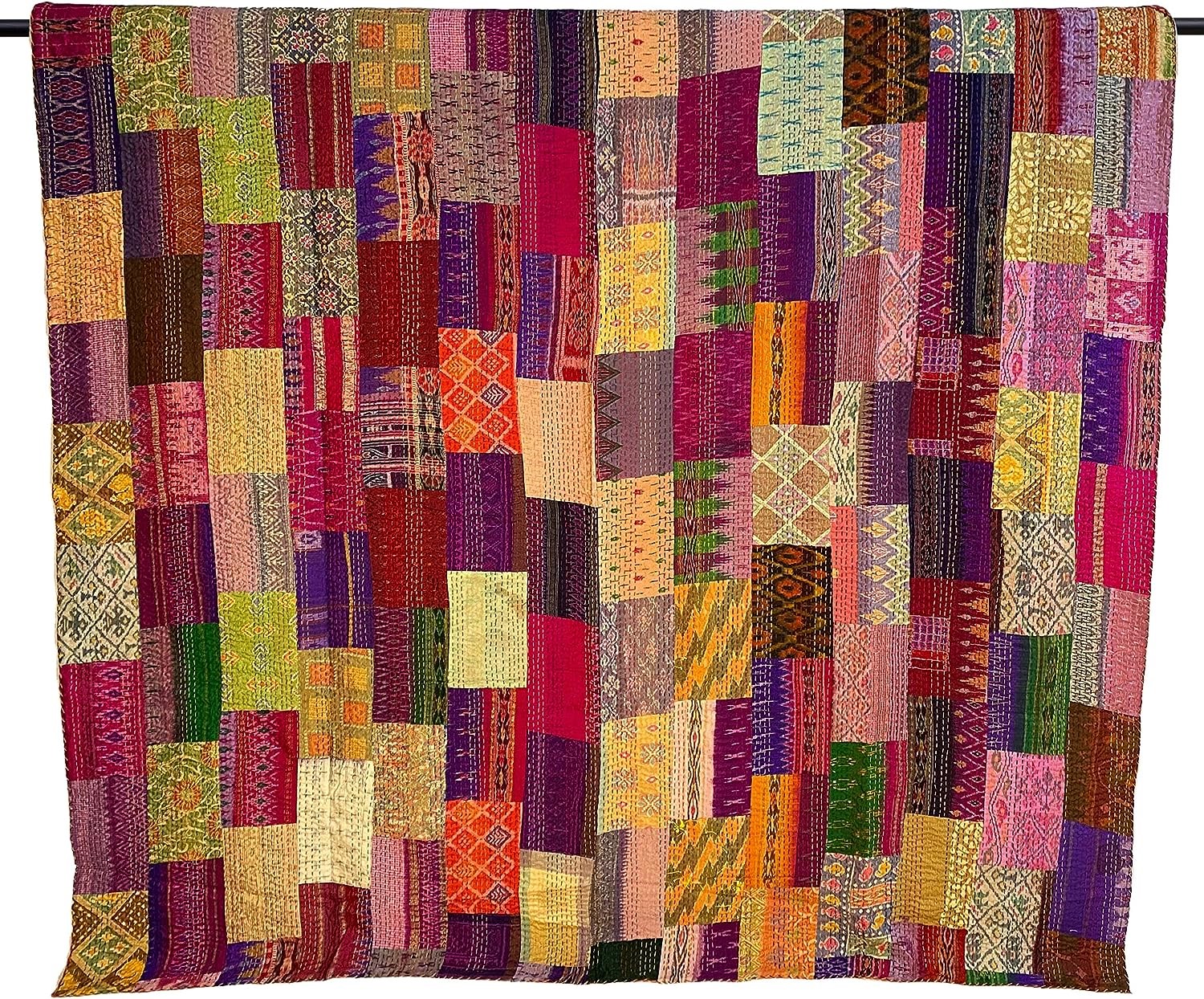
Source :
https://www.dsource.in/resource/applique-and-patchwork-kutch-gujarat/making-process
https://www.dsource.in/resource/applique-and-patchwork-kutch-gujarat/introduction
https://images-cdn.ubuy.co.in/641409f58f58bd093a3e7c45-sophia-art-indian-silk-sari-kantha.jpg
Craft Name: Gotta Patti
Location: Rajasthan
Community: Not Specific
Similar Crafts in the world:
Gota Patti, also known as ‘Aari Tari’, ‘zardozi’ or ‘Lappe ka Kaam’, is a traditional hand embroidery. Specifically, it is a type of appliqué-embroidery. Cities like Jaipur, Ajmer, Kota, Udaipur and Bikaner in Rajasthan are considered the main centres for gota Patti work.
Process:
- The craftwork process begins with motifs being drawn on tracing paper which is then perforated so that it can be used for tracing the design on the fabric.
- To ease the work of the artisans, the fabric is tied using sturdy cords on a wooden frame called adda.
- Chalk is used to mark where the motifs are to be traced.
- In the next step, motifs are traced on the fabric with cotton or cloth using a paste of chalk powder and kerosene oil.
- Gota patti is then pasted onto the traced parts of the fabric, and the edges are embroidered with zari thread to give it a more clean, finished look.
- This makes the result look more elegant.
- Following this, a peetan, which is a hammer/block made out of wood, is used to beat the entire fabric.
- Finally, the fabric is removed from the wooden frame and is ready to be sold.
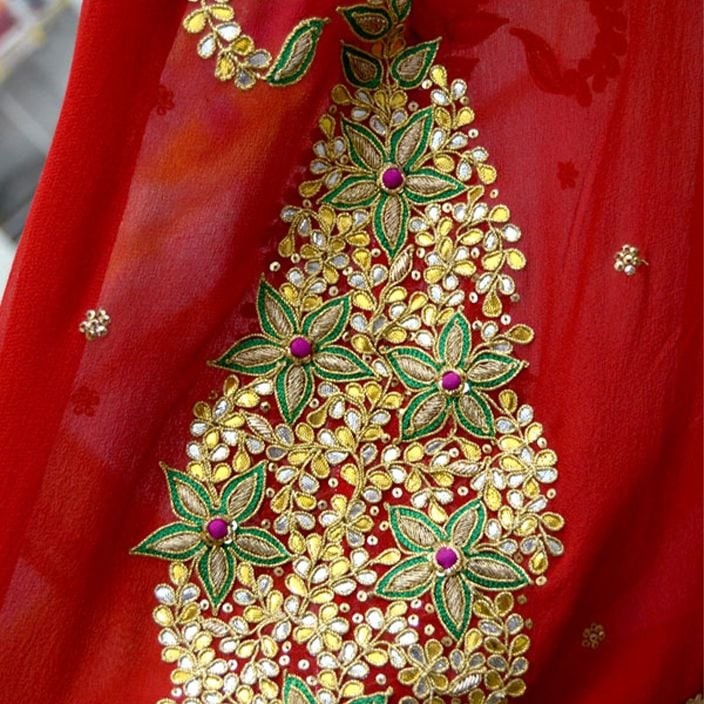
Source :
https://www.perniaspopupshop.com/encyclopedia/rajasthan/gota-patti#:~:text=History%20of%20gota%20patti%20can,later%20spread%20to%20other%20states
https://img.perniaspopupshop.com/store-locator-v2/uploads/DP_Main_Image_Gota_Patti_c8ca634392.jpg

